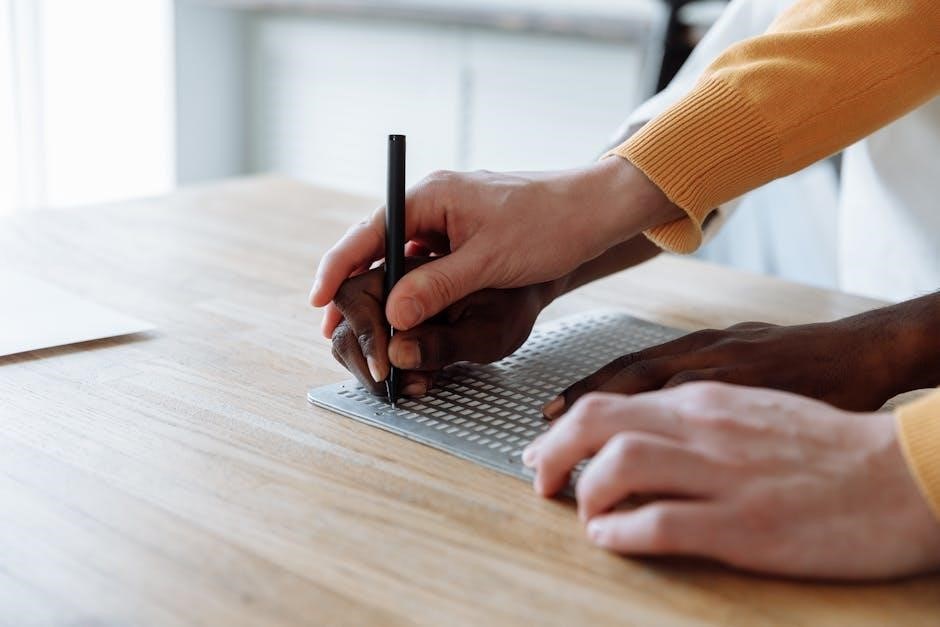Accurate dress measurements are essential for a perfect fit, ensuring comfort and style. They help avoid costly alterations and enhance your overall appearance.
Why Accurate Measurements Matter
Accurate dress measurements are crucial for ensuring a perfect fit, comfort, and style. Proper measurements help prevent ill-fitting garments, which can be uncomfortable and unflattering. They also reduce the need for costly alterations or returns, especially when shopping online. A well-fitted dress enhances confidence and overall appearance, making it essential to take precise measurements. Additionally, accurate measurements are vital for custom-made dresses, ensuring the garment drapes correctly and meets personal style expectations. By prioritizing precise measurements, individuals can achieve a tailored look without compromise.
Essential Measurements for Dresses
Key measurements include bust, waist, hips, and dress length, ensuring a tailored fit and comfort for various body types and styles.
Bust Measurement
The bust measurement is taken around the fullest part of the chest, typically over a well-fitting bra. To ensure accuracy, place the tape measure under the arms, across the shoulder blades, and level across the front. The tape should be snug but not too tight, forming a straight line across the back. This measurement is crucial for determining dress sizes and ensuring a comfortable fit. For accurate results, avoid slouching or pulling the tape too taut. If you’re measuring for a custom dress, double-check this measurement to avoid alterations later. Proper alignment and a relaxed posture will yield the most precise result, ensuring your dress fits perfectly.
Waist Measurement
The waist measurement is taken around the narrowest part of your natural waistline, typically just above the belly button. To measure accurately, stand upright and wrap the tape measure snugly but not too tightly around your torso. The tape should be level and parallel to the floor, ensuring it isn’t twisted or angled. This measurement is vital for determining the fit of dresses, especially those with defined waistlines. For the most precise result, wear a lightweight garment or undergarments that align with what you’ll wear under the dress. If your waist curves, take the smallest measurement around the circumference. Accurate waist measurements ensure a flattering and comfortable fit, particularly for styles like A-line or fitted dresses.
Hip Measurement
The hip measurement is taken around the widest part of your hips, typically 7-9 inches (18-23 cm) below your natural waistline. To measure accurately, stand with your feet hip-width apart and wrap the tape measure snugly around the fullest part of your hips. The tape should be level and parallel to the floor, ensuring it isn’t twisted. For the most precise result, wear lightweight clothing or undergarments. This measurement is crucial for dresses that flare or fit closely around the hips, such as A-line or bodycon styles. Accurate hip measurements ensure a balanced and flattering fit, especially for dresses with defined silhouettes or tailored designs. Proper alignment and a relaxed stance will yield the most accurate results for a comfortable and stylish fit;
Dress Length Measurement
Dress length measurement is crucial for achieving the desired fit and style. It is typically measured from the hollow of the neck (the indent at the base of the neck) down to the hem of the dress. Stand straight and relaxed while measuring, ensuring the tape measure is level and follows the natural curve of your body. For most dresses, standard lengths include mini (above the knee), midi (below the knee), and maxi (floor or ankle length). Custom measurements may also be taken to accommodate personal preferences or specific designs. Accurate length ensures the dress flatters your proportions and aligns with your intended look. Always consider your height and footwear when determining the ideal length for a polished appearance.

Understanding Dress Size Charts
Dress size charts match body measurements to sizes, ensuring a proper fit. They vary by brand, so comparing measurements is key for accurate sizing and comfort.
How to Read a Size Chart
Reading a size chart involves matching your body measurements to the corresponding size. Locate the chart on the product page and compare your measurements to the listed sizes. Pay attention to key measurements like bust, waist, and hips. Sizes vary by brand, so always refer to the specific chart provided for accurate sizing. Use a tape measure to ensure your measurements are precise. If your measurements fall between sizes, consider the fit you prefer—fitted or relaxed; Some charts include international size conversions, so verify the region if needed. Double-checking your measurements ensures a better fit and reduces the need for alterations. Always look for guidance notes or fit tips provided by the brand for additional clarity.
Standard vs. Custom Measurements
Standard measurements are pre-determined sizes based on average body types, while custom measurements are tailored to individual proportions. Standard sizes are convenient for quick purchases but may not fit perfectly. Custom measurements offer a precise fit, ideal for special occasions or unique body types. They often require professional tailoring or made-to-measure services, ensuring the dress flatters your body. Custom measurements can be more costly and time-consuming but provide superior comfort and style. Standard sizes are best for everyday shopping, while custom is recommended for a flawless fit. Understanding the difference helps you choose the right option for your needs, ensuring satisfaction with your purchase.

Preparing for Measurements
Wear tight, form-fitting clothing and stand upright for accurate results. Use a flexible tape measure and ensure proper alignment for precise measurements, avoiding any slack or twists.
What to Wear During Measurements
For accurate measurements, wear tight, form-fitting clothing such as a well-fitting bra, shapewear, or a thin tank top. Avoid loose garments that may distort your natural shape. Underwear should provide proper support without adding bulk. If measuring for a specific dress, wear similar undergarments you plan to use with it. Footwear can also impact length measurements, so wear the shoes you intend to pair with the dress. Ensuring a smooth, flat surface under the tape measure is key. Proper attire helps achieve precise, reliable measurements, ensuring the best fit for your dress.
Tools Needed for Accurate Measurements
To ensure precise dress measurements, gather essential tools. A flexible measuring tape, preferably plastic or fiberglass, is crucial for smooth, accurate readings. A full-length mirror allows you to verify proper tape placement. Enlist a helper for hard-to-reach areas, like the back. Use a flat, stable surface for laying garments flat when measuring. A pencil and paper or digital device are needed to record measurements. Some guides recommend a calculator for size conversions. Proper tools ensure consistency and accuracy, helping you achieve the best fit for your dress.


Step-by-Step Guide to Taking Measurements
Start by preparing the necessary tools, including a flexible measuring tape, a mirror, and a helper if needed. Begin with the bust measurement, wrapping the tape around the fullest part of your chest, ensuring it’s level and parallel to the floor. Next, measure your natural waistline, the narrowest point above your hips. For the hips, measure around the widest part, typically 7-9 inches below your waist. To determine dress length, measure from the desired neckline or shoulder down to the hem. Ensure the tape is straight and smooth for accurate results. Record each measurement carefully to reference when shopping or sewing. Consistency and precision are key to achieving a perfect fit.
Choosing the Right Dress Size
Selecting the correct dress size ensures a flattering fit and enhances confidence. Begin by comparing your recorded measurements to the size chart provided by the retailer or designer. Pay attention to how measurements correspond to bust, waist, and hip sizes. Consider the dress style and fabric; stretchy materials offer flexibility, while structured fabrics require precise fit. If between sizes, opt for the larger to ensure comfort. Custom sizing is ideal for a tailored look, especially for formal or wedding dresses. Always check international size conversions if shopping from global brands. Remember, sizing can vary between brands, so don’t hesitate to contact customer service for guidance. Accurate size selection ensures your dress looks and feels its best, making every occasion memorable.



